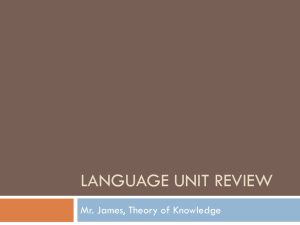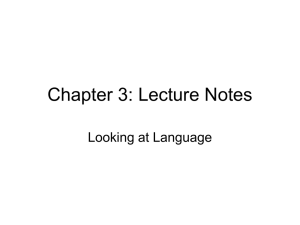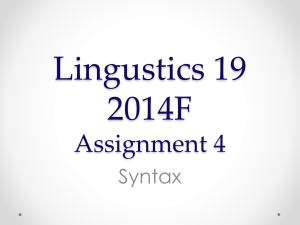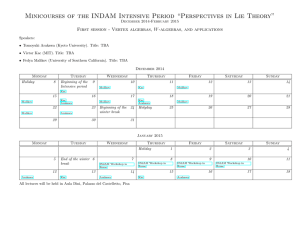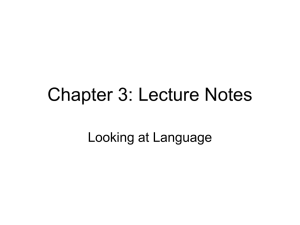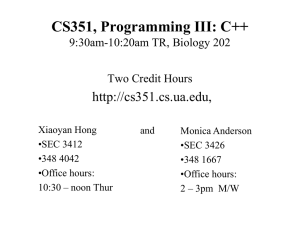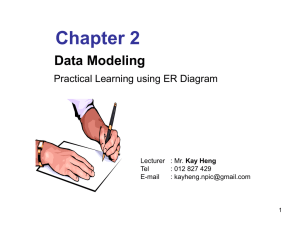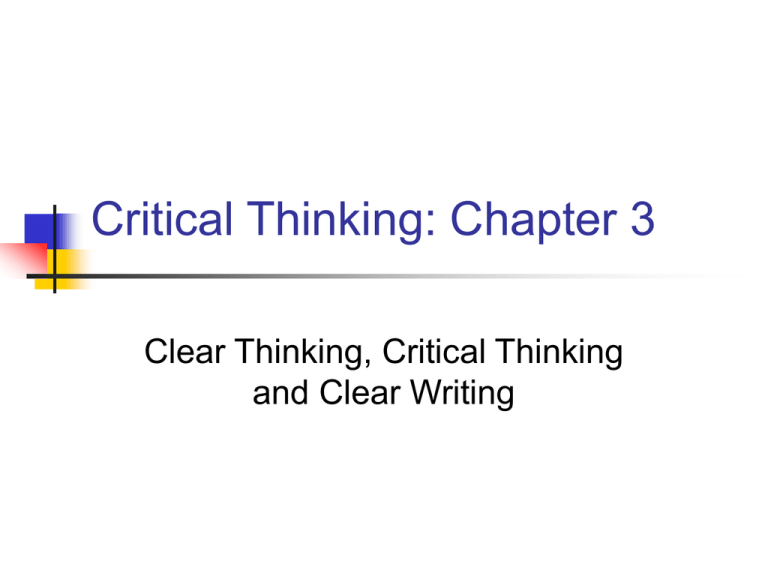
Critical Thinking: Chapter 3
Clear Thinking, Critical Thinking
and Clear Writing
Organization and Focus
You can’t write well if you are not
organized!
Your essay should support your position
or answer anticipated objections.
Organization and Focus
Use good examples!
Make your point, back it up, give an
example, and then move on to your next
point.
Five Good Writing Practices
1. Outlining is important.
2. Revising is very important.
3. Have someone else read your essay
and make suggestions.
4. Read your essay out loud.
5. Come back to it later.
The Principle of Focus
Make clear at the outset what issue you
intend to address and what your
position on the issue will be.
The Principle of Sticking to the
Issue
All points you make in an essay should
be connected to the issue under
discussion.
The Principle of Logical
Sequencing
Make a point before clarifying it and
make sure your reader can discern the
relationship between any given
sentence and your ultimate goal.
The Principle of
Completeness
Support fully and adequately whatever
position you take on an issue.
Five Common Problems
1. Define your terms! Any serious
attempt to support or sustain a
position requires a clear
statement of what is at issue.
Sometimes stating what is at
issue involves a careful
definition of key terms.
Types of Definitions
1. Definition by example
2. Definition by synonym, and
3. Analytical definition
Definition by Example
Pointing to, naming, or describing one
or more examples of something to
which the defined term applies.
Example: What I mean by setting a
good example is not putting your feet on
the table.
Definition by Example
Examples: Happiness is having your
own DVD burner.
A professional bureaucrat is anyone like
our former Governor Davis, who spent a
lifetime in government.
Real property? Why, your house and
land are real property.
Definition by Synonym
Giving another word or phrase that
means the same thing.
Examples: “Poltroonery” means the
same thing as “cowardice.”
“Dacha” is another word for “Russian
country house.”
Definition by Synonym
Examples: “Hit me” means the same as
“Give me another card.”
Being an octogenarian is being in one’s
eighties.
To fledge an arrow is to fletch or feather
it.
Analytical Definition
Specifying (a) the type of thing the term
applies to and (b) the difference
between the things the term applies to
and other things of the same type.
Example: A deciduous tree is a
hardwood tree that loses its leaves
during the winter.
Analytical Definition
Examples: “Widow” refers to a woman
whose husband has died.
Honor means being willing to lay down
your life for a just cause.
Meat that contains larval worms is said
to be measly.
Five Common Problems
2. Keep your word choices simple.
Good writing is often simple
writing: It avoids redundancy,
unnecessary complexity, and
wordiness.
Example: Why write armed
gunmen? Gunmen are
automatically armed.
Simple Word Choices
Example: Why write: “They expressed
their belief that at that point in time it
would accord with their desire not to
delay their departure” when all that is
necessary is “They said they wanted to
leave”?
Simple Word Choices
Because the world is a complicated
place, the language we use to describe
it often has to be correspondingly
complicated. Sometimes it is necessary
to be complicated to be clear. But, in
general, simplicity is the best policy.
Five Common Problems
3. Avoiding ambiguity. A claim is
an ambiguous claim if it can be
assigned more than one
meaning and if the particular
meaning it should be assigned
is not made clear by context.
Avoiding Ambiguity
3. Avoiding ambiguity
A. Semantic ambiguity is
ambiguous due to a particular
word or phrase.
Examples: She disputed his claim.
Did she dispute his statement or
his claim to a gold mine?
Semantic Ambiguity
Example: My brother doesn’t use
glasses. What does “glasses” mean?
He does not drink out of glasses or he
does not have eye glasses? Avoid
ambiguity by substituting an
unambiguous word such as eyeglasses
for glasses. Sometimes you will need
several extra words.
Five Common Problems
3. Avoiding ambiguity
B.Syntactic ambiguity is
ambiguous because of the
structure of the sentence
rather than a word or phrase
as with semantic ambiguity.
The words are not confusing
but the word order is.
Syntactic Ambiguity
Example: He chased the girl in his car.
What does this mean? Did he chase a
girl already inside his car? Or did he
chase a girl (perhaps in another car)
with his car?
Syntactic Ambiguity
Example:There’s somebody in the bed
next to me. What does this mean?
Whose bed? Are you in a dorm room
where there are more than one bed and
in another bed there is a body, or did
you wake up to find someone in your
bed?
Pronouns
The boys chased the girls, and they
giggled a lot. Who giggled? Who does
the pronoun “they” refer to?
Avoiding Ambiguity
The only way to eliminate syntactic
ambiguity is to rewrite the claim. For
example, “he brushed his teeth on the
carpet” could be rewritten as “he
brushed his teeth while standing on the
carpet.”
Five Common Problems
3. Avoiding ambiguity
C. A grouping ambiguity
means “whenever we refer to a
collection of individuals, we
must clearly show whether the
reference is to the collection as
a group or as individuals.”
Grouping Ambiguity
Example: Secretaries make more
money than physicians. Individually, no;
as a group, yes. Whenever we refer to a
a collection of individuals, we must
clearly show whether the reference is to
the collection as a group or as
individuals.
Five Common Problems
3. Avoiding ambiguity
D. The fallacy of composition
means that we confuse when
something holds true of a
group of things individually
then they will automatically
hold true of the same things as
a group.
The Fallacy of Composition
Example: Sampras and Agassi are the
two best tennis players in the United
States, so they would make the best
doubles team. Is this true? Just
because they can play best individually
does not mean that if you put them
together they would be the best couples
team.
Five Common Problems
3. Avoiding ambiguity
E. The fallacy of division is
when a person who thinks that
what holds true for a group will
necessarily hold true of all the
individuals in that group.
The Fallacy of Division
Example: The Eastman School of Music
has an outstanding international
reputation; therefore, so and so, who is
on the faculty of Eastman, must have a
good reputation. Not true. Just because
you go to a good school does not mean
that every teacher will be good.
Examples of Ambiguity
“Priestess” was hooker to jury (AP
headline).
There will be over one hundred
consolation prizes worth over $10,000.
The girls played with the boys.
Why you want sex changes as you age.
Analytical Definitions
“Adult beverage” is anything that will get
you drunk and make you act like an
adolescent.
Analytical Definitions
Skiing—outdoor fun combined
with knocking down trees with
your face.
—Dave Barry
Analytical Definitions
“Conservative, n. A statesman
who is enamored of existing evils,
as distinguished from a liberal,
who wishes to replace them with
others.”
—Ambrose Bierce
Five Common Problems
4. Vague claims can be confused
with ambiguous claims, but
they are different. Ambiguous
claims can mean different
things and we are unsure what
to pick. Vague claims mean we
are unsure of any meaning.
Vague Claims
Vagueness is not really the problem so
much as an undesirable degree of
vagueness. Even though a claim may
be less precise than it could be, that
does not mean it is less precise than is
should be. It depends on what you need
the information for.
Vague Claims
Example: If you want to move your car
and you ask the usher how long you
have until the play begins, the reply
“Only a minute or two” is less precise
than is possible, but it will work. It
means you don’t have enough time. But
you might want a more precise time if
you are the lead actor in the film.
Examples of Vagueness
Men burn off 438 calories per hour
gardening.
Doctor: The arrhythmia you are
experiencing indicates that you should
lay off jogging for awhile.
“Your satisfaction is guaranteed with our
two-year limited guarantee.”
Five Common Problems
5. Making faulty comparisons.
This is especially a problem
with politicians and
advertisers. Think about things
like “Cut by up to half.” But
how much really? “Now 25
percent larger.” Larger than
what?
Questions for Comparisons
Is important information missing?
Is the same standard of comparison
being used?
Are the items comparable?
Is the comparison expressed as an
average?
Averages
Statistics are notoriously slippery
partially because there are three
different ways of talking about
averages, the mean, the median, and
the mode.
Mean Average
The arithmetic mean of a group of
numbers is the number that results
when their sum is divided by the
number of members in the group.
Example: “The average grade in the
class is total of all the grade points
divided by the number of people in the
class.”
Median Average
In a group of numbers, as many
numbers of the group are larger than
the median as smaller.
Example: “The average grade in the
class is the halfway grade, which half
the class exceeded and half the class
fell short of.”
Mode Average
In a group of numbers, the mode is the
number occurring most frequently.
Example: The average grade in the
class is the most common grade given.”
Writing in a Diverse Society
Part of what people have to
decide when listening to you
(or reading your work) is
whether or not you are
credible. And using poor
language lowers your
credibility, just as using poor
arguments does.
Writing in a Diverse Society
“it is important to avoid writing in a
manner that reinforces
questionable assumptions and
attitudes about people…”
Writing in a Diverse Society
Thinking critically is about being
better able to think in more
depth about more complex
issues.
So much of our stereotypic use of
language is a result of lazy
thinking and easy clichés.
Exercises
For each of the following, indicate whether
the definition given is by example, by
synonym, or analytical.
A loquacious person is a talkative
one.
Exercises
For each of the following, indicate whether the
definition given is by example, by synonym, or
analytical.
A loquacious person is a talkative one.
By synonym
Exercises
For each of the following, indicate whether the
definition given is by example, by synonym, or
analytical.
A diode is a solid-state electronic device that allows
the passage of an electric current in only one
direction.
Exercises
For each of the following, indicate whether the definition
given is by example, by synonym, or analytical.
A diode is a solid-state electronic device
that allows the passage of an electric current
in only one direction.
Analytical
Exercises
For each of the following, indicate whether the
definition given is by example, by synonym, or
analytical.
The oud is a stringed musical instrument shaped
much like a guitar and played primarily in Middle
Eastern countries.
Exercises
For each of the following, indicate whether the
definition given is by example, by synonym, or
analytical.
The oud is a stringed musical instrument shaped
much like a guitar and played primarily in Middle
Eastern countries.
Analytical
Exercises
For each of the following, indicate whether the
definition given is by example, by synonym, or
analytical.
“Epistemologist” means a philosopher or other
intellectual who studies the nature of knowledge.
Exercises
For each of the following, indicate whether the
definition given is by example, by synonym, or
analytical.
“Epistemologist” means a philosopher or other
intellectual who studies the nature of knowledge.
Analytical
Exercises
For each of the following, indicate whether the
definition given is by example, by synonym, or
analytical.
“Foppish” means “dandy.”
Exercises
For each of the following, indicate whether the
definition given is by example, by synonym, or
analytical.
“Foppish” means “dandy.”
Synonym
Exercises
Determine which of these claims are best
classified as semantically ambiguous (and which
of those contain grouping ambiguities), which are
syntactically ambiguous, and which are free from
ambiguity.
Semantic ambiguity is ambiguous due
to a particular word or phrase.
Exercises
Semantic ambiguity is ambiguous due to a
particular word or phrase.
Syntactic ambiguity is ambiguous because of
the structure of the sentence rather than a
word or phrase as with semantic ambiguity.
The words are not confusing but the word
order is.
Exercises
Determine which of these claims are best classified as
semantically ambiguous (and which of those contain
grouping ambiguities), which are syntactically ambiguous,
and which are free from ambiguity.
People who go shopping often go broke.
Exercises
Determine which of these claims are best classified as
semantically ambiguous (and which of those contain
grouping ambiguities), which are syntactically ambiguous,
and which are free from ambiguity.
People who go shopping often go broke.
Semantically ambiguous: “go broke,” and
syntactically ambiguous: does “often” go with
“shopping” or with “go broke”?
Exercises
Determine which of these claims are best classified as
semantically ambiguous (and which of those contain
grouping ambiguities), which are syntactically ambiguous,
and which are free from ambiguity.
All snakes are not poisonous.
Exercises
Determine which of these claims are best classified as
semantically ambiguous (and which of those contain
grouping ambiguities), which are syntactically ambiguous,
and which are free from ambiguity.
All snakes are not poisonous.
Syntactically ambiguous
Exercises
Determine which of these claims are best classified as
semantically ambiguous (and which of those contain
grouping ambiguities), which are syntactically ambiguous,
and which are free from ambiguity.
He went to the store but was held up in the process.
Exercises
Determine which of these claims are best classified as
semantically ambiguous (and which of those contain
grouping ambiguities), which are syntactically ambiguous,
and which are free from ambiguity.
He went to the store but was held up in the process.
Semantically ambiguous
Exercises
Determine which of these claims are best classified as
semantically ambiguous (and which of those contain
grouping ambiguities), which are syntactically ambiguous,
and which are free from ambiguity.
The team was upset.
Exercises
Determine which of these claims are best classified as
semantically ambiguous (and which of those contain
grouping ambiguities), which are syntactically ambiguous,
and which are free from ambiguity.
The team was upset.
Semantical ambiguity on “upset” and
grouping ambiguity on “team”
Exercises
Determine which of these claims are best classified as
semantically ambiguous (and which of those contain
grouping ambiguities), which are syntactically ambiguous,
and which are free from ambiguity.
She watched him dance with intensity.
Exercises
Determine which of these claims are best classified as
semantically ambiguous (and which of those contain
grouping ambiguities), which are syntactically ambiguous,
and which are free from ambiguity.
She watched him dance with intensity.
Syntactically ambiguous
Exercises
Determine which of these claims are best
classified as semantically ambiguous (and which
of those contain grouping ambiguities), which are
syntactically ambiguous, and which are free from
ambiguity.
San Francisco (AP)—“A group of citizens angry
about the lack of public restrooms downtown is
planning a sit-in at City Hall, leaving employees
no place to go.”
Exercises
San Francisco (AP)—“A group of citizens
angry about the lack of public restrooms
downtown is planning a sit-in at City Hall,
leaving employees no place to go.”
Semantically and syntactically
ambiguous; they work together in this one.
Exercises
Determine whether these claims are too vague in the
contexts that are stated or implied.
During his first news conference of the year, the
president said today that his administration was
going to crack down even harder on international
terrorism.
Exercises
Determine whether these claims are too vague in the
contexts that are stated or implied.
During his first news conference of the year, the
president said today that his administration was
going to crack down even harder on international
terrorism.
Too vague to be very informative; this speaks
as much of an attitude as it does of plans to combat
terrorism.
Exercises
Determine whether these claims are too vague in the
contexts that are stated or implied.
Said at a party: “What did I think of the concert? I
thought it was pretty good. You should have been
there.”
Exercises
Determine whether these claims are too vague in the
contexts that are stated or implied.
Said at a party: “What did I think of the concert? I
thought it was pretty good. You should have been
there.”
Fine, under the circumstances
Exercises
Determine whether these claims are too vague in the
contexts that are stated or implied.
My aunt lost most of her possessions when her
house burned down last month.
Exercises
Determine whether these claims are too vague in the
contexts that are stated or implied.
My aunt lost most of her possessions when her
house burned down last month.
Sufficiently precise for most contexts; too
vague, of course, if the remark is directed to an
insurance claims agent
Exercises
Determine whether these claims are too vague in the
contexts that are stated or implied.
Well, let’s see. To get to the Woodward Mall, go
down this street a couple of blocks, and turn right.
Go through several stoplights, turn left, and go just a
short way. You can’t miss it.
Exercises
Determine whether these claims are too vague in the
contexts that are stated or implied.
Well, let’s see. To get to the Woodward Mall, go
down this street a couple of blocks, and turn right.
Go through several stoplights, turn left, and go just a
short way. You can’t miss it.
Hopelessly vague
Exercises
Determine whether these claims are too vague in the
contexts that are stated or implied.
I can’t tell you how much I love you. You make me
very happy.
Exercises
Determine whether these claims are too vague in the
contexts that are stated or implied.
I can’t tell you how much I love you. You make me
very happy.
Vagueness is not inappropriate here.
Exercises
Determine whether these claims are too vague in the
contexts that are stated or implied.
Property owner, showing his property to
guests: “The lot extends back to about where that
large oak tree stands.”
Exercises
Determine whether these claims are too vague in the
contexts that are stated or implied.
Property owner, showing his property to
guests: “The lot extends back to about where that
large oak tree stands.”
Precise enough
Exercises
Determine whether these claims are too vague in the
contexts that are stated or implied.
Same property owner, showing his property to
a potential buyer: “The lot extends back to about
where that large oak tree stands.”
Exercises
Determine whether these claims are too vague in the
contexts that are stated or implied.
Same property owner, showing his property to
a potential buyer: “The lot extends back to about
where that large oak tree stands.”
Too vague
Exercises
For each of the following, give an analytical
definition that is flattering.
conservative (noun):
Exercises
For each of the following, give an analytical
definition that is flattering.
conservative (noun): a person whose
political views are guided by the
wisdom embodied in traditional
institutions
Exercises
For each of the following, give an analytical
definition that is flattering.
politician:
Exercises
For each of the following, give an analytical
definition that is flattering.
politician: one dedicated to public benefit
through governmental service
Exercises
For each of the following, give an analytical
definition that is flattering.
liberal:
Exercises
For each of the following, give an analytical
definition that is flattering.
liberal: a person whose political
philosophy is guided by ideas of
democracy, reform, and progress
Exercises
For each of the following, give an analytical
definition that is unflattering.
liberal:
Exercises
For each of the following, give an analytical
definition that is unflattering.
liberal: a politician who can’t keep
out of your wallet.
Exercises
For each of the following, give an analytical
definition that is unflattering.
conservative:
Exercises
For each of the following, give an analytical
definition that is unflattering.
conservative: a politician who dictates
to others what they can do in their
bedrooms.
Exercises
For each of the following, give an analytical
definition that is unflattering.
physicians:
Exercises
For each of the following, give an analytical
definition that is unflattering.
physicians: people who prescribe
medicines of which they know little, to cure
diseases of which they know less, in human
beings of whom they know nothing
(attributed to Voltaire)

